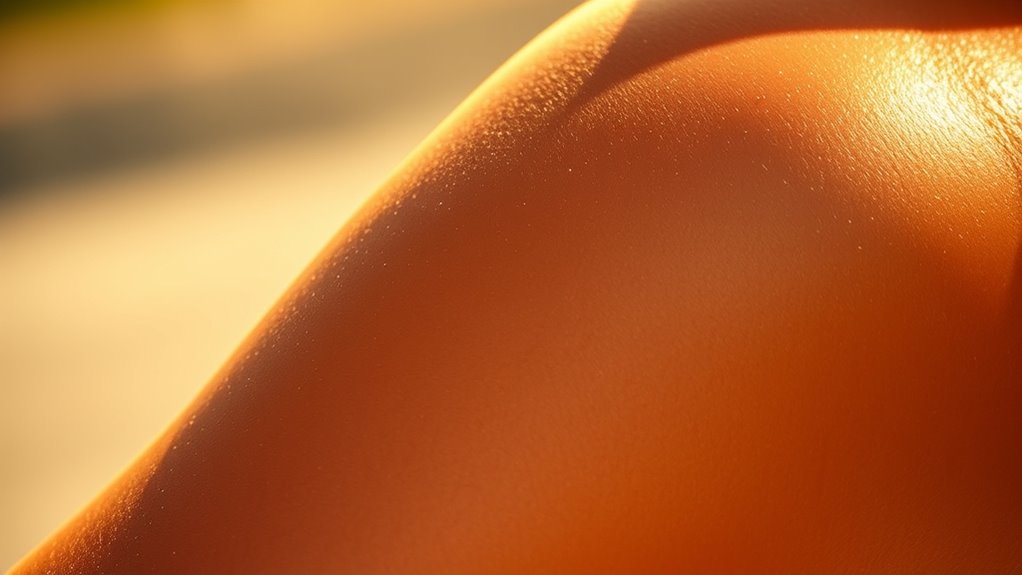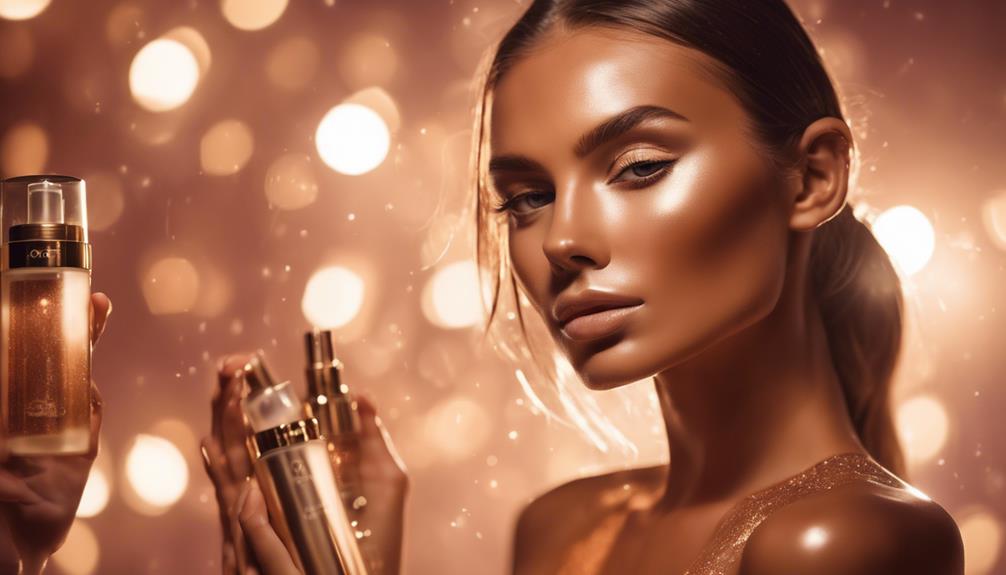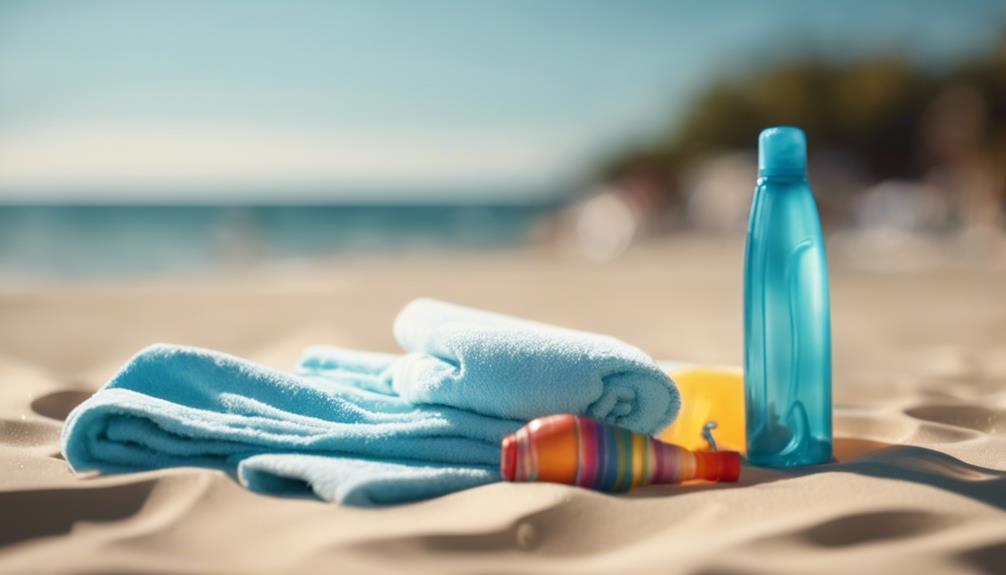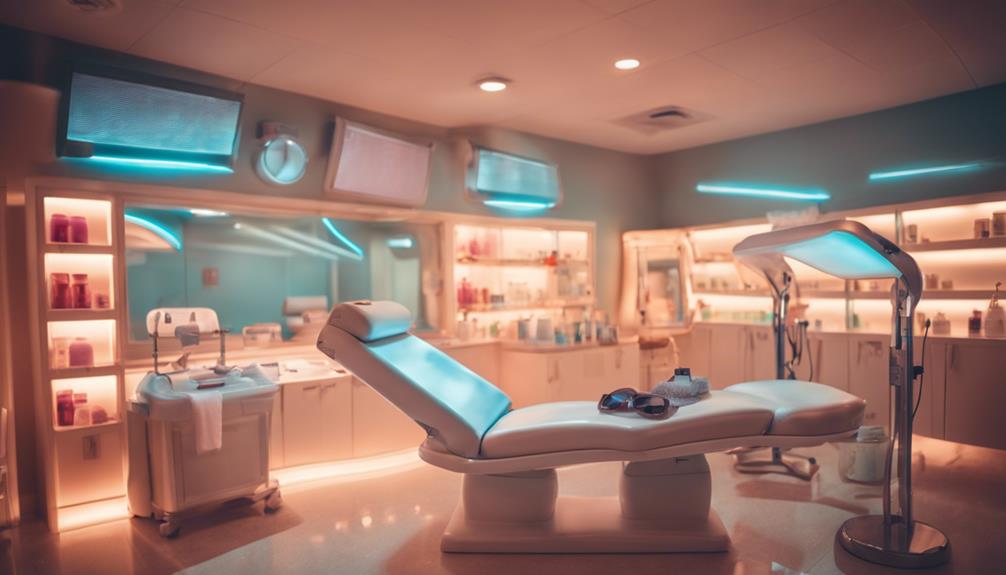A perfect tan comes from a mix of science and proper application. DHA, the main ingredient in sunless tanners, reacts with amino acids on your skin’s surface to create a natural-looking bronze through a Maillard process. Your skin’s genetics, age, and sun exposure influence how well you tan. To get the best results, prepare your skin, apply evenly, and protect your tan by caring for and safeguarding your skin. Keep exploring to discover more tips and techniques.
Key Takeaways
- DHA reacts with skin amino acids to produce a temporary, natural-looking bronze via the Maillard reaction.
- Genetic factors and skin type influence how the skin responds to DHA and UV exposure.
- Proper preparation, exfoliation, and application tools ensure an even, streak-free tan.
- Maintaining hydration, avoiding exfoliation, and applying SPF extend the longevity of the tan.
- Advances in tanning technology focus on natural results, safety, and personalized formulations.
How DHA Creates a Natural-Looking Tan
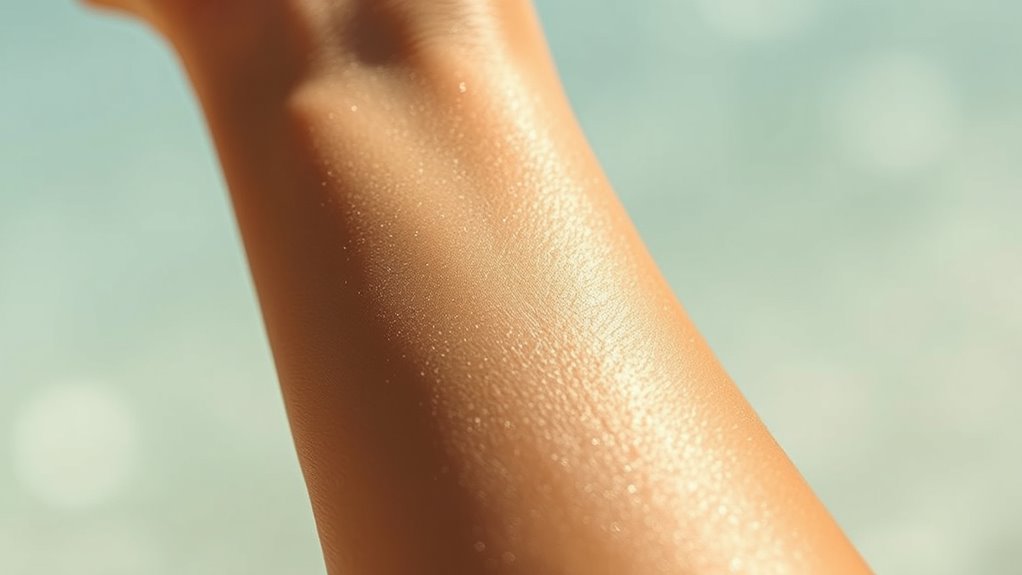
DHA creates a natural-looking tan by reacting with amino acids on the skin’s outer layer, the stratum corneum. This reaction forms melanoidins through a non-enzymatic Maillard process, producing a brown coloration that mimics a tan. Unlike UV exposure, this process is safe because it doesn’t involve harmful rays. When you apply DHA-based products, it binds to proteins in the skin’s outermost cells, causing a bronze hue. The reaction mainly involves amino acids like glycine, alanine, leucine, and valine, which react differently to create a range of tones from yellow to deep brown. Since the process is temporary, your skin naturally sheds these outer cells over time, gradually fading the tan. The results depend on the concentration of DHA used, with higher levels producing more intense shades. Additionally, advances in AI-powered mobile processing are enabling more personalized skincare recommendations to optimize tanning results. Understanding the chemical reaction involved helps consumers choose products that yield the most natural and desirable outcomes, especially as formulation science continues to improve product stability and color development. Moreover, ongoing research into skin chemistry is helping to refine formulations for more predictable tanning effects.
Biological Factors That Influence Tanning Results
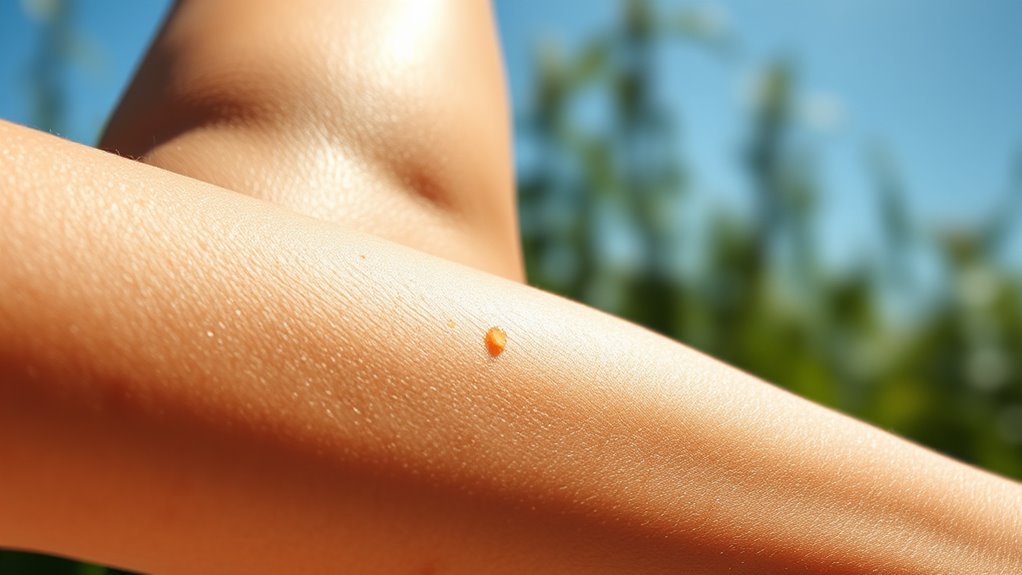
Your skin’s natural ability to tan is heavily influenced by genetics, with studies identifying around 20 genes that determine how your skin responds to sunlight. Genes like *IRF4*, *TYR*, and *EXOC2* regulate pigment production and distribution, affecting your susceptibility to tanning or burning. The MC1R receptor and α-MSH hormone pathways mediate UV-induced melanin synthesis, acting as key signals for pigmentation. Transcription factors such as MITF and USF1 serve as molecular switches that control melanin production after UV exposure. Your baseline skin color also plays a role—darker skin types produce more melanin in response to UV, providing natural protection. Age and sex further influence tanning, with hormonal and behavioral factors impacting how your skin reacts to sun exposure.
Essential Steps for Optimal Application and Formulation
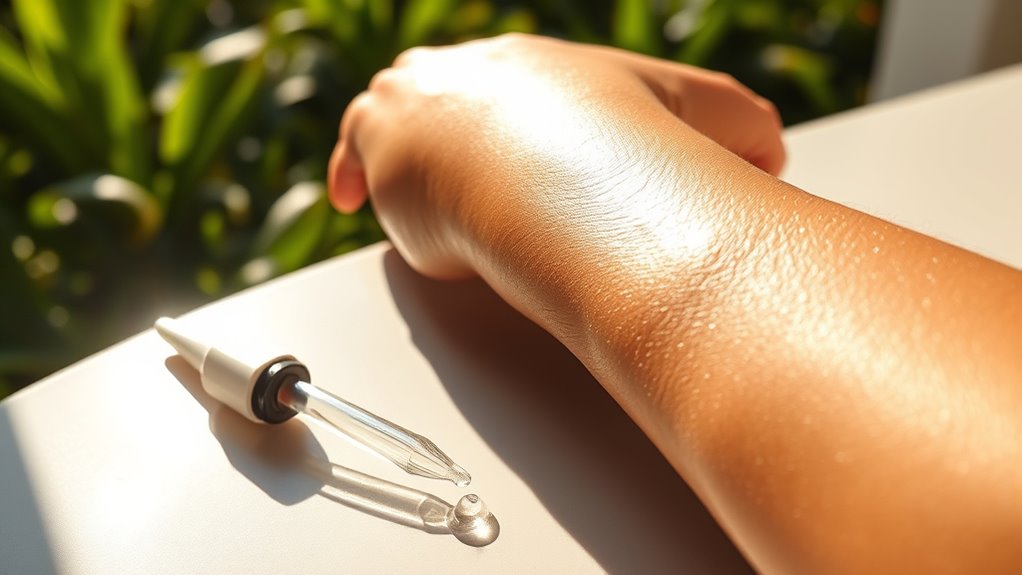
Have you ever wondered how to achieve an even, natural-looking tan? Start by prepping your skin at least 24 hours before application. Exfoliate to create a smooth surface and remove dead skin, ensuring even color. Remove hair beforehand to avoid streaks and uneven patches. Steer clear of deodorants and perfumes that can interfere with absorption. Choose a tan product suited to your skin type, like mousse or lotion, and moisturize with a tanning-friendly product to boost longevity. During application, use tools like an applicator mitt for seamless coverage, blending well around joints and sensitive areas. Wait the recommended 4-8 hours for the tan to develop fully. Proper preparation and technique are key to achieving a flawless, natural glow that lasts.
Ensuring Safety and Longevity of Your Sunless Tan
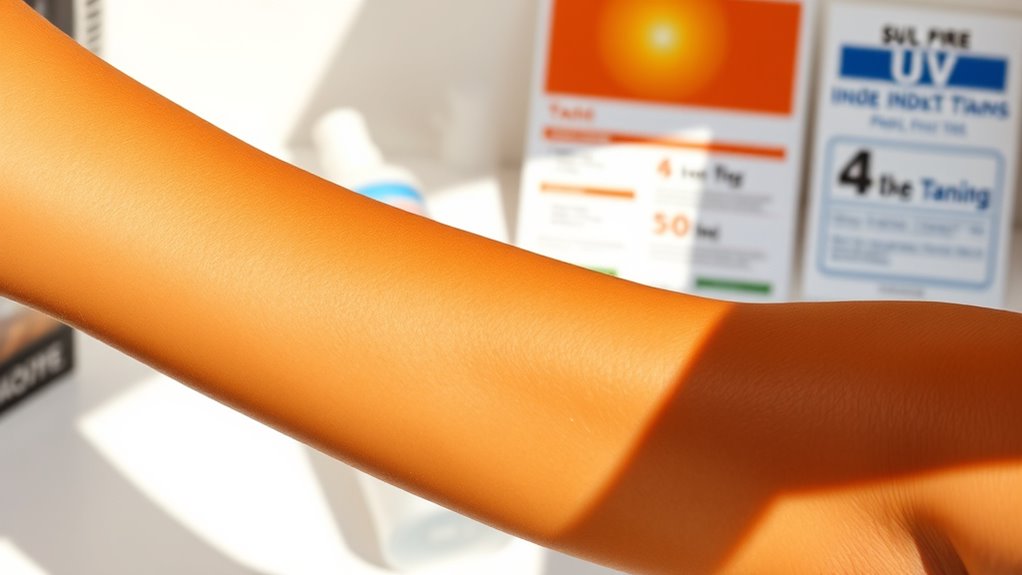
Ensuring the safety and longevity of your sunless tan requires mindful practices and awareness of potential risks. Sunless products with DHA are generally safe, but always do a patch test to check for skin sensitivities. Protect your eyes, nose, and mouth during spray tanning to avoid inhalation risks. While the ingredients are considered non-toxic, more research on long-term effects is needed. To extend your tan, avoid sweating, chlorinated water, and excessive exfoliation. Keep your skin moisturized to help preserve the color. Remember to apply sunscreen with SPF 30 or higher—self-tanners provide minimal protection—especially when exposed to UV rays. Protecting your skin and following these tips ensures a safe, vibrant tan that lasts longer. Also, maintaining good indoor air quality can help prevent skin issues related to pollutants and irritants. Incorporating proper exfoliation techniques can help maintain an even and long-lasting tan by removing dead skin cells without damaging the skin. Additionally, understanding the role of data privacy challenges in skincare technology can help consumers make informed choices about products that utilize personal data. Being aware of dog-friendly travel guidelines can also ensure you and your pet enjoy safe and comfortable trips when heading to outdoor or vacation destinations. Furthermore, selecting reputable sunless tanning products and avoiding those with questionable ingredients can significantly reduce potential health risks.
Current Trends and Innovations in Tanning Technologies
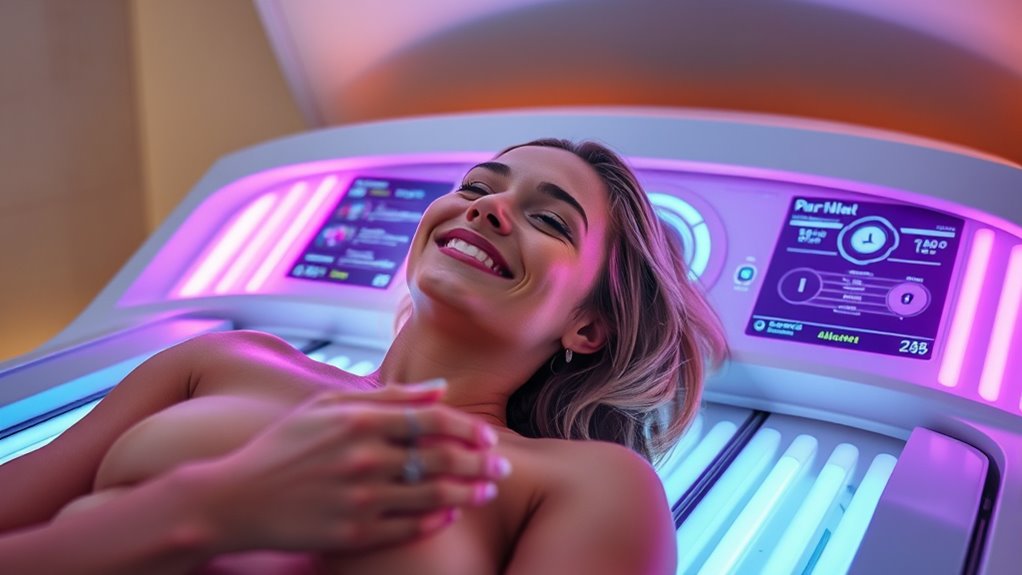
Advancements in tanning technologies are shaping the future of achieving a beautiful, even glow with greater precision and convenience. The global spray tanning market is projected to reach $10.2 billion by 2030, fueled by rising awareness of sun damage and demand for healthier options. Aroma oil diffusers are increasingly being integrated into spa settings to enhance relaxation and provide a more holistic approach to skin wellness. The integration of advanced application techniques ensures more uniform and natural-looking results, reducing the risk of streaks or uneven fading. Incorporating UV protection awareness into these innovations can help consumers make more informed choices about their tanning routines. Clean beauty trends are pushing brands to create formulations with fewer ingredients and no harsh chemicals. Personalization is key, with professionals crafting custom blends to match your skin tone perfectly. Tanning is becoming more inclusive, catering to all skin tones and offering additional benefits. Innovations like skincare-tanning hybrids, rapid express solutions, and automated booths are making treatments faster and more efficient. Integration with red light therapy and digital management tools further enhance your experience, ensuring safer, tailored, and more effective tanning methods. Additionally, the rise of custom formulations allows for more natural-looking results that complement individual skin types.
Frequently Asked Questions
How Does Skin Type Affect DHA Absorption and Tan Color?
Your skin type influences how much DHA you absorb and the resulting tan color. If your skin is dry, you’ll absorb more DHA, leading to a darker, richer tan. Oily skin absorbs less, resulting in a lighter shade. Skin texture and pigmentation also play roles, affecting how evenly DHA develops. Proper prep, like exfoliation, can improve absorption and help you achieve a more natural, uniform tan tailored to your skin type.
Can Diet Influence the Longevity of a Sunless Tan?
You might wonder if diet can help your sunless tan last longer. Eating foods rich in beta-carotene, like carrots and spinach, can boost your skin’s natural pigmentation, enhancing your tan’s appearance. Staying hydrated with water and hydrating foods helps maintain skin moisture, supporting the tan’s longevity. Avoid excessive alcohol and sugar, which can dehydrate your skin and cause faster fading. A balanced diet promotes healthy skin, extending your tan’s fade-free period.
Are There Natural Alternatives to DHA for Tanning?
Yes, there are natural alternatives to DHA for tanning. You can try plant-based ingredients like aloe vera, coconut oil, and jojoba oil, which hydrate your skin and give a subtle glow. Red raspberry ketones and botanical formulas also offer a sun-kissed look without harsh chemicals. Gradual tanning products made from these natural ingredients help you achieve a healthy, golden tan over time, with added skin nourishment and fewer risks.
How Do Environmental Factors Impact the Tanning Process?
Ever wonder how the environment influences your tan? You’ll find that UV radiation, affected by factors like altitude, latitude, and weather, plays a key role in skin tanning. High UV levels speed up tanning but also increase risks. Clouds, pollution, and reflective surfaces can reduce or intensify UV exposure, impacting your tan’s depth and evenness. Temperature and humidity further influence how your skin reacts to UV, shaping your overall tanning experience.
What Are Potential Long-Term Skin Health Effects From Repeated Tanning?
Repeated tanning can cause serious long-term skin health issues. You might notice your skin becoming irregular in texture, developing wrinkles, age spots, or leathery and sagging skin. It also damages your skin’s DNA, increasing your risk of skin cancer, including melanoma. Each session accelerates skin aging and can lead to irreversible changes. Overall, frequent tanning substantially harms your skin’s health and appearance over time, making it a risky habit to maintain.
Conclusion
Achieving a perfect tan isn’t just about appearance; it’s backed by science. Did you know that DHA, the key ingredient, reacts with your skin’s amino acids to create that natural glow? By understanding biological factors and following proper application steps, you can enjoy a safe, long-lasting tan. With innovation in tanning tech rising, you’re now better equipped than ever to get that flawless, sun-kissed look—safely and confidently.
